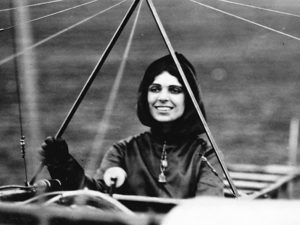In October 1910, Harriet Quimby watched an air show where top aviators competed. It was The International Aviation Tournament held in Belmont Park, New York. The highlight was an aerial race from the park to the Statue of Liberty. Harriet, known for her love of driving fast cars, decided to learn to fly.
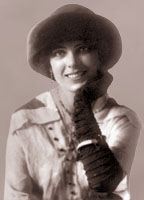
Harriet Quimby
Harriet and her friend Matilde Mosiant took flying lessons in 1911. They were two of the first five students at Matilde’s brother’s school. The famous aviator, Louis Bleriot, trained Harriet’s instructor. Bleriot was the first person to fly solo across the English Channel.
Harriet wrote about her experience flying in Leslie’s Illustrated Weekly, the magazine she worked for. She encouraged women to fly. And to “abandon skirts and don a knickerbocker uniform.” Harriet designed her own flight suit. It was made of purple wool, backed with satin, and included a hood. There were large buttons on the skirt. When buttoned, they became pantaloons.

Harriet In Her Flight Suit
On August 1, 1911, Harriet became the first American woman to earn a pilot’s license. She flew in aerial exhibitions. On September 4, 1911, she became the first woman to fly at night. She flew over a crowd on Staten Island, New York. She was part of the Moisant Aviation Exhibition Team.
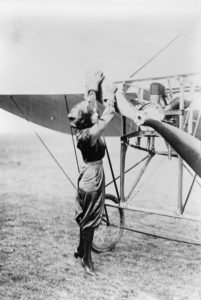
Harriet and Matilde, along with the Moisant team, celebrated the inauguration of the new Mexican president. They were hired to perform in an airshow. According to one of Harriet’s biographers, Matilde dropped roses when she flew over the president’s palace. Harriet and Matilde became the first women to fly over Mexico City.
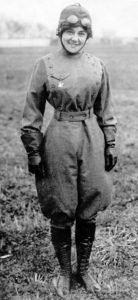
Matilde Moisant
Harriet decided to follow in Louis Bleriot’s footsteps and become the first woman to cross the English Channel. She kept her plan a secret not wanting to invite competition. Harriet sailed to England on March 7, 1912. In France, she met Bleriot. She borrowed one of his monoplanes and had it shipped to England.
On April 16, Harriet took off from Dover, England. She attempted to cross the channel and land in Calais, France. With a compass on her lap, she flew into fog. But she was able to cross the channel successfully. She landed on a beach 25 miles from Calais. The excited beachgoers carried Harriet on their shoulders.

As the first woman to pilot a plane across the English Channel, Harriet’s name would have been the top headline in newspapers. But two days before her flight, the “unsinkable” Titanic hit an iceberg and sank. Stories about the Titanic ran for weeks.
Harriet continued flying exhibitions in America. Unfortunately, she, like so many early aviators, died while flying. On July 1, 1912, she flew at the Third Annual Boston Aviation Meet in Squantum, Massachusetts. Harriet and a passenger, William Willard, flew in Harriet’s new Bleriot two-seater. Something went wrong with the plane and Harriet lost control. Both she and Willard died. Harriet was only 37 years old.
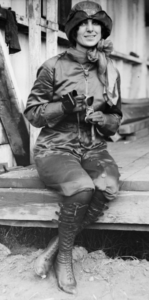
Harriet will always be remembered as one of early aviation’s stars. She was the first American woman to receive a pilot’s license and the first woman to fly solo across the English Channel.
If you like this post, then please consider sharing it and leaving a comment below. Thank you! Barbara Lowell, Children’s Author
To Learn More, Visit the International Women’s Air & Space Museum at: http://www.iwasm.org
You may also like: Amelia Earhart Crosses The Atlantic https://barbaralowell.com/amelia-earhart-crosses-atlantic
Barnstorming Bessie Coleman https://barbaralowell.com/barnstorming-bessie-coleman
Elinor Smith Teenage Flying Flapper https://barbaralowell.com/elinor-smith-flying-flapper
Books For Kids:

Brave Harriet
by Marissa Moss, Illustrated by C.F. Payne

